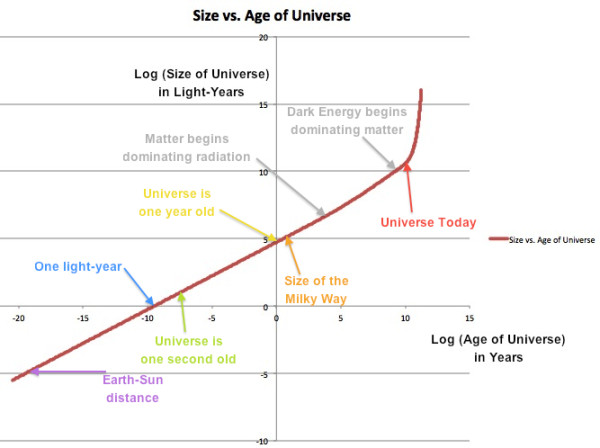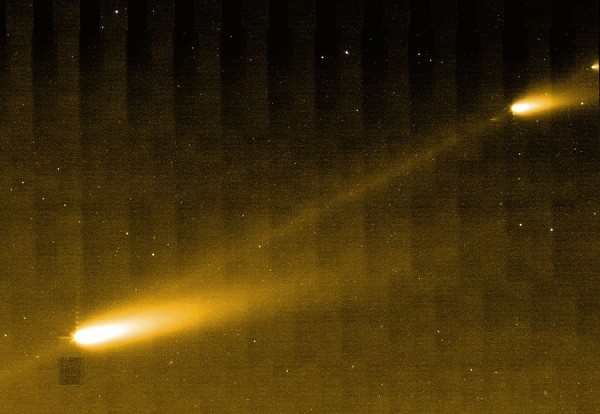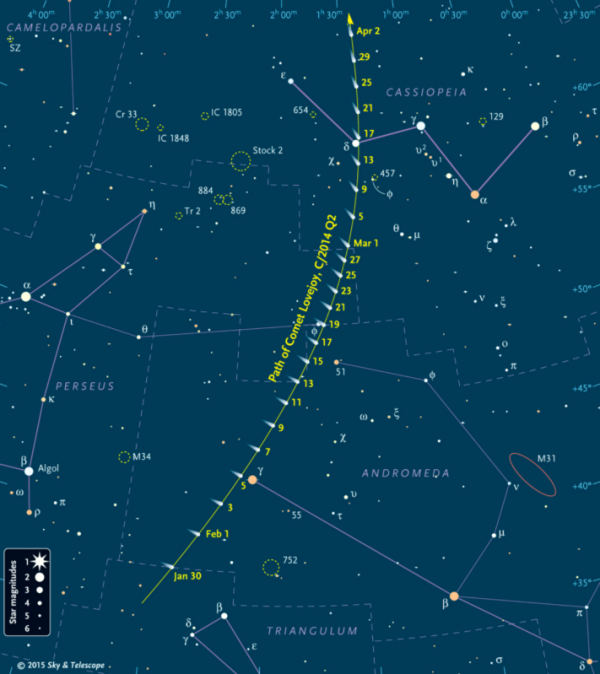“In this land of ours, there are many great pits. But none more bottomless than the bottomless pit. Which, as you can see here, is bottomless.” -Grunkle Stan, Gravity Falls
After another week of fun-filled stories about the Universe here at Starts With A Bang, it's time to take a look back at everything we've said, as well as everything you've said in response. If you missed anything (or simply want a second look), here's what we've covered over the past week:
- How can we still see the Big Bang? (for Ask Ethan),
- The math of Powerball (for our Weekend Diversion),
- A comet comes alive! (for Mostly Mute Monday),
- Observing Night,
- Don't trust your theoretical "proof", and
- The science of bottomless pits (for Throwback Thursday).
As always, although I'm proud of what I've had to say, I'm also incredibly intrigued and stimulated by what you've had to say. That's why we keep a forum here, and you didn't disappoint (you never do) when it comes to comments. So I've chosen my favorites to respond to, and that'll be this edition of our Comments of the Week!
Image credit: Wikimedia Commons user Unmismoobjetivo; of a logarithmic view of the Universe as centered on the Earth.
From Joseph McFarland, the "asker" of our Ask Ethan: "I’d been pondering the issue for a while, but keep hitting a logical inconsistency on it after researching multiple sources implying a universe inflated to the size of a grapefruit at the time of the CMB radiation release."
There is a big difference between "the Universe" and "our observable Universe," and this is often a point of confusion by people who use them interchangeably. Our observable Universe, right now, is about 46.1 billion light years in radius, from our point of view. You can extrapolate that back in time, and find out how big it was at any given epoch in the matter-and-radiation filled state that existed post-inflation. Here, I've done it for you!
The size of a grapefruit, if you like, is about 0.1 meters, or about 10^-17 light years. That will happen on this graph at a time of roughly 10^-43 years, or 10^-35 seconds, give or take. So, assuming that:
- Inflation ended and the hot Big Bang began at a time that corresponds to t=10^-35 seconds,
- The Universe that we observe is the entirety of the Universe, and that
- Inflation lasted for the minimum possible amount of time,
then yes, that thing you heard is almost right. But no matter how you slice it, the Universe was already tens of millions of light years in size by time the CMB was emitted. Don't let them get away with it!
Image credit: Aaron Pero of KRON4, via http://kron4.com/2015/02/08/powerball-jackpot-grows-to-450-million/.
From Jim on the Math of Powerball: "All the math is in keeping with the spirit of this blog, but a lot of people who play aren’t really buying a chance to win a few hundred million dollar. They are buying a fantasy. For $2 dollars, you get to say, “When I win the lottery …” do a little daydreaming."
This is the kind of "gambling" I have no problem with at all. If you're doing it for entertainment value, because it's amusing and you enjoy it, and because there are absolutely no consequences for you if you lose (i.e., that money is disposable), there's no reason not to play the lottery.
On the other hand, despite mandatory warnings that lottery games should not be played for investment purposes, that's exactly what many people do: they look at it as a strategic way to use their income.
 Image credit: snapshot from YouTube video https://www.youtube.com/watch?v=rjEYV7lvjwM.
Image credit: snapshot from YouTube video https://www.youtube.com/watch?v=rjEYV7lvjwM.
That's why it's so important to get the information about the math out there: people need to know what they're getting themselves into!
Which is why I get to say you're welcome to Chip Hart: "Just wanted to say thanks for the long-form article. I got up this morning to prepare a quick segment on this topic for a group of middle school Mathcounts kids and this not only saved me a ton of time…it’s really an outstanding job, covering all the bases. Thanks!"
I did Mathcounts as a kid, by the way, and for a 13-year-old kid who wasn't popular or confident in pretty much anything he did, it was a great activity for me. Somewhere in my parents' house, I believe, is still my second-place-in-the-state-competition trophy from 1992. You're welcome, Chip, and glad I could help someone involved in an activity that actually had a positive impact on my life.
Image credit: ESA/Rosetta/NAVCAM — CC BY-SA IGO 3.0, via http://www.esa.int/spaceinimages/Images/2015/02/Comet_on_9_February_201….
From Josef Nedstam on comet tails: "For us who haven’t studied comet tails since Halley was here in -86, can you say something about the direction the comet is moving in for these different shots? I’m aware the tail doesn’t follow the comet, but which way is it?"
The thing about comet tails is that there are two of them. There's the dust tail, which points away from the Sun but curves in its orbit due to the orbital path, and there's the ion tail, which always points directly away from the Sun. This was first noted, by the way, back in the 1500s by Tycho Brahe.
 Image credit: Tycho Brahe's notebook on the great comet of 1577, via wikimedia commons user Sevenfold.
Image credit: Tycho Brahe's notebook on the great comet of 1577, via wikimedia commons user Sevenfold.
Before Brahe, perhaps unbelievably, the consensus view was that comets were atmospheric phenomena, but Brahe's observations were able to definitively show that, at the very least, it was beyond the orbit of the Moon.
From David Hurn on comets: "I think Edmond Halley must have been the first scientist to successfully predict the future!"
When it comes to comets, there's no doubt of that. But before Halley, Kepler predicted transits of Venus and Mercury, Ptolemy predicted the orbits of the planets, and pre-historic Babylonians (among others) were able to predict lunar and solar eclipses. Halley's prediction was spectacular, and his precise prediction of the return of the comet which bears his name in 1758 was a tremendous achievement, but let's not take credit away from all the incredible scientists who preceded him!
From Sinisa Lazarek on Observing Night: "On the other hand, didn’t know about the Lovejoy comet. Cool! Will definately have to look for it."
As wonderful as observing night was -- and in particular, Jupiter, Uranus, the Mizar/Alcor binary (of which four stars were visible), and the Orion Nebula were spectacular -- at least from my urban location in Portland, OR, Comet Lovejoy was not only gone visually, it was inaccessible to our CCD camera. Someone in darker locations with very long exposure (and large aperture) equipment might be able to find it, but we weren't. Sorry.
From Michael Kelsey on theoretical proofs: "I am so glad to see I’m not the only one who has made this mistake
The number 1E+100 is a “googol”, and the number 1E+(1E+100) is a “googolplex”."
Looks like I'll need a suplex to straighten it out?
 Image credit: World Wrestling Entertainment, via http://wrestlingwithtext.com/tag/german+suplex.
Image credit: World Wrestling Entertainment, via http://wrestlingwithtext.com/tag/german+suplex.
Yup, that's my mistake. But on the other hand, there is some part of me that will always be delighted by cartoonish violence, I suppose. Thanks for the setup to indulge in that.
From Sean T, also on theoretical proofs: "Of course, another reason that a mathematical theorem could produce a result that does not agree with observation is that the mathematical framework that we originally thought was appropriate for the physical situation is, in fact, not appropriate."
This is very astute, and I would go further and state that the mathematical framework might still be appropriate, but it might not be 100% of the story, and that's interesting (and can lead to wildly different results), too.
 Image credit: Chegg, via http://www.chegg.com/homework-help/questions-and-answers/consider-neutr….
Image credit: Chegg, via http://www.chegg.com/homework-help/questions-and-answers/consider-neutr….
For example, neutral pions can decay into two photons, but not three photons. There's a symmetry -- charge conjugation symmetry -- that's 100% conserved in electromagnetic decays, and the neutral pion does decay via an electromagnetic process. The charge conjugation symmetry states that even numbers of photons are allowed (so, 2, 4 and 6), but not odd numbers (e.g., 1, 3, 5, etc.) of photons. Yet when we investigate, we find that yes, it doesn't decay into three photons, but it doesn't decay into four photons, either!
Why not? Because there's more to the story, and an additional restriction (and an additional theorem: Furry's Theorem) that prevents that decay. The overarching point is that while, with math, you can have an isolated, idealized system, in physics, you always have the whole Universe to contend with!
And finally, from Ian on the physics of a bottomless pit: "I am not sure about the accuracy of the speed of the diver when he reaches the center of the earth in his vacuum pit. The 11km/s speed assumes constant acceleration of 9.81m/s. What would the speed be as G changes on the way down. As the diver approaches the center of the Earth, G will be substantially reduced as a great deal of the Earth’s mass will be behind him. It looks like some calculus will be required here."
You are right, Ian. If you insist on using the force calculation, going through the center of the Earth, etc., and worrying about mass distribution, speed, etc., you will have to do the calculus to figure it out. It's a terrifyingly messy calculation, and one you can only make assumptions about. You'll find, pretty much no matter what you do, that there isn't a constant acceleration, and that I couldn't have assumed that.
Thankfully, this calculation is interesting enough -- it was proposed by Hooke in the 17th century -- that it has been worked out in detail.
My maximum speed needs to be reduced by about 28%: 7,900 km/s is the maximum speed of a gravity train here on Earth, and a one-way trip would actually take 42.2 minutes.
So those are your comments of the week; I hope you enjoyed them and thanks for a great one. See you back here soon for more wonders -- and more joys -- of the Universe!
- Log in to post comments








Shame about Lovejoy :(
Guess we're out of luck as far as bright comets, last year around this time.. same thing, different comet.
While on subject, will 67P/Churyumov-Gerasimenko be visible from earth with low apertures?